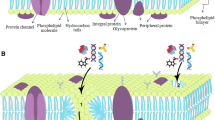Summary
cDNA clones were isolated for a chloroplast protein, the mRNA of which is induced to maximum levels within 2–4 h after onset of illumination in five day old, etiolated pea seedlings.
The cDNA library was constructed from poly(A)+-mRNA which was isolated from 4 h illuminated seedlings. The extremely short induction period of the early light induced protein(ELIP)-mRNA established the basis of our screening procedure. Colony hybridization experiments were performed with32P-labelled cDNA probes, synthesized from RNA of seedlings which had been exposed to different programs of illumination. Plasmid DNAs were isolated from colonies showing strong hybridization signals exclusively with cDNA corresponding to the 4 h-mRNA. Hybrid released translation of preselected plasmids p 17/C2 and p17/C4 revealed a peptide of Mr 24 000. After posttranslational importin vitro, the processed product of Mr 17 000 appears in the chloroplast. Using these clones, the expression of the ELIP-mRNA was investigated by DOT-hybridization. The ELIP-mRNA reaches maximum levels within 2–4 hours after onset of illumination. Our results correspond precisely to thein vivo characteristics and indicate positive identification of the sought clones.
Similar content being viewed by others
References
Apel K, Kloppstech K: The plastid membranes of barley (Hordeum vulgare). Light-induced appearance of mRNAs coding for the apo-protein of the light-harvesting chlorophyll a/b protein. Eur J Biochem 85: 581–588, 1978.
Batschauer A, Apel K: An inverse control by phytochrome of the expression of two nuclear genes in barley (Hordeum vulgare L.). Eur J Biochem 143: 593–597, 1984.
Bedbrook JR, Smith SM, Ellis RJ: Molecular cloning and sequencing of cDNA encoding the precursor to the small subunit of chloroplast RuBPCase. Nature 287: 692–697, 1980.
Birnboim HC, Doly J: A rapid alkaline extraction procedure for screening recombinant plasmid DNA. Nucleic Acids Res 7: 1513, 1979.
Broglie R, Bellemare G, Bartlett SG, Chua NH, Cashmore AR: Cloned DNA sequences complementary to mRNAs encoding precursors to the small subunit of ribulose-1,5-bisphosphate carboxylase and a chlorophyll binding polypeptide. Proc Natl Acad Sci 78:7304–7308, 1981.
Domoney C, Casey R: Storage protein precursor polypeptides in cotyledons of Pisum sativum L. Identification of, and isolation of a cDNA clone for, an 80 000 Mr legumin related polypeptide. Eur J Biochem 139: 321–327, 1984.
Grunstein M, Hogness DS: Colony hybridization: A method for the isolation of cloned DNAs that contain a specific gene. Proc Natl Acad Sci 72:3961–3965, 1975.
Hampp R, de Filippis LF: Plastid protease activity and prolamellar body transformation during greening. Plant Physiol 65: 663–668, 1980.
Hanahan D: Studies on Transformation of Escherichia coli with Plasmids. J Mol Biol 166: 557–580, 1983.
Maniatis T, Fritsch EF, Sambrook J: Molecular cloning: a laboratory manual. Cold Spring Harbor Laboratory, New York, 1982.
Mc Master GK, Carmichael GC: Analysis of single and double-stranded nucleic acids on polyacrylamide and agarose gels by using glyoxal and acridin orange. Proc Natl Acad Sci 74: 4835–4838, 1977.
Meyer G, Kloppstech K: A rapidly light-induced chloroplast protein with a high turnover coded for by pea nuclear DNA. Eur J Biochem 138: 201–207, 1984.
Ricciardi RP, Miller JS, Roberts BE: Purification and mapping of specific mRNAs by hybridization selection and cell-free translation. Proc Natl Acad Sci 76: 4927–4931, 1979.
Rigby PWJ, Dieckmann M, Rhodes C, Berg P: Labelling deoxyribonucleic acid to high specific activityin vitro by nick translation with DNA polymerase I. J Mol Biol 113: 237, 1977.
Roychoudhoury R, Jay E, Wu R: Terminal labelling and addition of homopolymer tracts to duplex DNA fragments by terminal deoxynucleotidyl transferase. Nucleic Acids Res 3: 863–877, 1976.
Stiekema WJ, Wimpee CF, Silverthorne J, Tobin E: Phyochrome control of the Expression of Two Nuclear Genes Encoding Chloroplast Proteins in Lemna gibba L. Plant Physiol 72: 717–724, 1983.
Author information
Authors and Affiliations
Rights and permissions
About this article
Cite this article
Scharnhorst, C., Heinze, H., Meyer, G. et al. Molecular cloning of a pea mRNA encoding an early light induced, nuclear coded chloroplast protein. Plant Mol Biol 4, 241–245 (1985). https://doi.org/10.1007/BF02418242
Received:
Revised:
Accepted:
Issue Date:
DOI: https://doi.org/10.1007/BF02418242




